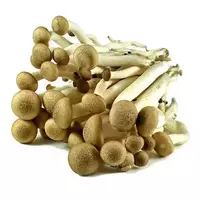Shimeji

An unusual name for shimeji hides a type of oyster mushroom that grows mainly in East Asian countries. By the way, shimeji gained the greatest popularity and love in Japan, where they are preferred to other types of mushrooms. This attachment of the local population is associated with the distinctive properties of mushrooms, which are characterized by a crunchy and fairly stable structure.
Shimeji mushrooms are distinguished by a special pleasant aroma and a soft-creamy taste with a slight sweet tinge. In color, mushrooms can be either brown or practically white - this quality of shimeji depends on the variety. However, the most famous are light gray mushrooms, the diameter of the caps of which varies from 2 to 10 centimeters.
In order for this exotic product for our country to remain fresh for longer, it must be stored correctly. First of all, shimeji mushrooms cannot be washed, but just put them in a paper bag, covering it with wet wipes, and then store them in the refrigerator. In plastic containers, these mushrooms deteriorate very quickly. It is worth noting that when chilled, this type of mushroom is suitable for food for only twenty days.
In the raw form, shimedzhi is categorically not advised to eat: despite the fact that it is almost impossible to poison them, they are poorly digested without thermal treatment. Although, even if you want to try raw shimeji, you can hardly enjoy it - they taste bitter enough. Moreover, this bitterness disappears even after minimal heat treatment.
You can cook shimeji in different ways: fry, extinguish, salt, cook, marinate or bake. These mushrooms are great for soups, or even better deep-fried - so the shape and special texture of the shimeja are perfectly preserved. By the way, the famous dish of Japanese cuisine - "tempura" - is just based on the fact that pieces of vegetables, along with seafood and mushrooms, take turns dunking in batter, and then fried in boiling oil.
The unique aroma and special taste of shimeji can be further emphasized if you add spices or spices - these mushrooms are very capable of quickly absorbing new odors. The features of shimeji are best shaded by chaber and thyme. In addition to these aromatic herbs, you can call shallots, garlic and olive oil, which also make up an excellent composition with these oyster mushrooms.
Fried fish, meat or poultry, bell peppers and tomatoes, even citrus fruits acquire brand new flavorful notes combined with shimeji mushrooms. However, this product is also good as an independent dish, for example, as an original side dish for a roast. Additionally, it is worth noting that these mushrooms are considered a fairly common component for many vegetable salads.
Shimeji 43 kKal
Energy value of shimeji (Ratio of proteins, fats, carbohydrates - ju):
Proteins: 3.31 g (~ 13 kCal)
Fats: 0.41 g (~ 4 kCal)
Carbohydrates: 4.17 g (~ 17 kCal)
Energy ratio (bj | y): 31% | 9% | 39%
 Español
Español Français
Français Português
Português Русский
Русский 简体中文
简体中文 繁體中文
繁體中文 日本語
日本語 한국어
한국어 العربية
العربية Türkçe
Türkçe Қазақ
Қазақ Deutsch
Deutsch Italiano
Italiano Українська
Українська
